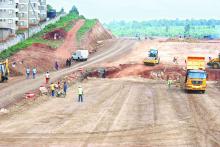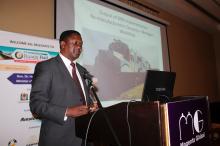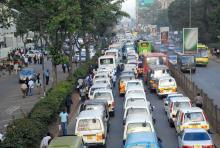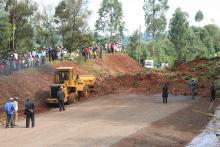East Africa’s ambitious road expansion programme is seeing the network expand significantly – Shem Oirere writes
The East Africa countries of Kenya, Tanzania, Uganda and Rwanda have announced ambitious road sector expansion plans in the 2015/16 financial year. This is despite their national budgets being weighed down by huge deficits and persisting lack of capacity to spend resources allocated to the sector in previous years.
With the huge budget deficits, the countries will have to look for alternati
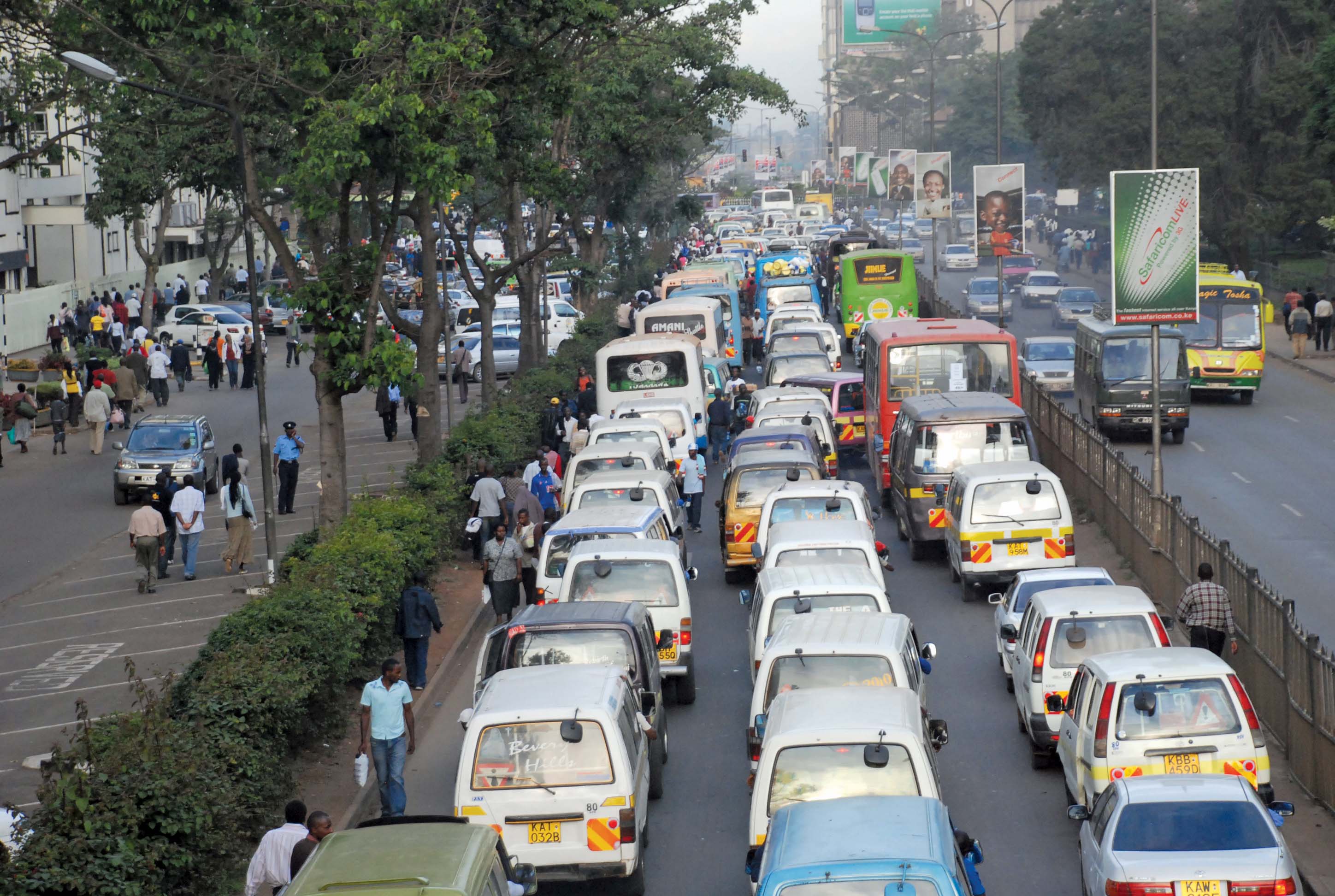
Nairobi needs to tackle its congestion problem, which can be particularly acute at peak periods
East Africa’s ambitious road expansion programme is seeing the network expand significantly – Shem Oirere writes
The East Africa countries of Kenya, Tanzania, Uganda and Rwanda have announced ambitious road sector expansion plans in the 2015/16 financial year. This is despite their national budgets being weighed down by huge deficits and persisting lack of capacity to spend resources allocated to the sector in previous years.
With the huge budget deficits, the countries will have to look for alternative financing sources to implement the many road projects contained in their financial statements, which were released concurrently on 11 June this year.
For the case of Kenya, finance minister Henry Rotich unveiled a US$13.2 billion budget out of which nearly $1.3 billion was allocated to the road sector expansion works, including ongoing road construction, road maintenance, foreign financed roads and the Road Annuity Programme.
The road sector allocation was higher than the $1.1 billion and $954 million for the 2014/15 and 2013/14 financial years respectively.
Rotich said the increment in allocation is meant to “enhance the productivity and competitiveness of the economy”.
Although the minister said that this year’s budget deficit climbed to slightly more than $4.9 billion, meeting the total development expenditure, financial needs will be addressed through factoring external financing of up 5.2% of the national budget and an additional 3.5% of the total budget from domestic financing.
Kenya also hopes to get more financing from its Sovereign Euro bond and other capital markets fund-raising initiatives to meet its road sector expansion financial challenges. “Last year our debut Sovereign Euro bon was received with a lot of enthusiasm by foreign investors,” said Rotich.
“We intend to continue sourcing these types of funds, including from export credit agencies and syndicated loans,” he said.
Despite the annual increase of financing for the road sector in the national budget, the Kenya Roads Board said the funds are a far cry from the needed $3.8 billion to clear the backlog of road maintenance across East Africa’s largest economy. The board’s executive director Jacob Ruwa said current annual road maintenance requirements run to $487 million compared to the $260 million allocated in this financial year.
He said that because of the budgetary constraints, the board is looking at alternative financing mechanisms such as vehicle inspection fees, insurance levy, infrastructure bond and review of the Road Maintenance Levy Fund rate to close the gap.
“There are several sources of funds which need to be followed up further to provide the funds needed to clear the road projects backlog and to have adequate maintenance on the road network such as the involvement of the private sector in public–private partnerships (PPP) through such schemes as concessioning, build–operate–transfer (BOT), Fund Rehabilitate, maintain and transfer and infrastructure bonds,” he said.
Kenya – like the rest of the economies in East Africa – is considering non-traditional bilateral sources – especially China, which is coming out strong in financing transport sector projects in the region.
In Uganda, China is financing the $350 million Kampala-Entebbe Expressway under a contract awarded to2661 China Communications Construction Company Ltd. The 37km modern highway has the backing of the China Export/Import Bank.
The Kampala road project is one of the Ugandan infrastructure initiatives that are also benefiting from construction equipment from China being part of a 40-year loan of $106 million from the world’s biggest economy.
In the medium-term Uganda plans to upgrade 1,500km of road from gravel to bitumen standard. The1069 Uganda National Roads Authority also plans to rehabilitate and reconstruct up to 700km of old paved roads to reduce the maintenance backlog. Among the roads given priority are those leading to the oil-rich Albertine Graben to facilitate more exploration and evacuation of oil and also those leading to tourist attraction sites.
During the 2015/16 financial year, the strategy is to accelerate infrastructure development to address the constraints of private sector growth and increase efficiency in service delivery. Uganda has increased development expenditure by 58% “mainly driven by major infrastructure development projects including new roads”.
Finance minister Matia Kasaija announced allocation of $936 million to improve transport infrastructure countrywide, which is 18.2% of the total budget allocation for the current financial year.
Neighbouring Rwanda is betting on paving of its road network to achieve objectives of the second Economic Development and Poverty Reduction Strategy. The government has allocated the road projects $10.2 million in the 2015/16 financial year but could need much more because of its unique geographical disposition. Road network maintenance in the country is said to be twice as high compared to other sub-Saharan African countries because of its mountainous terrain and excessive rainfall, which is known to cause severe erosion even along national and rural roads.
Rwanda’s ministry of infrastructure said under the government-backed Rwanda Transport Sector Development Project the country plans to “restore parts of major road corridors to good condition through rehabilitation works on the Kigali-Ruhengeri road and maintenance works on about 50% of the national road network”. The World Bank is the lead financier for the $11 million rehabilitation works on the 83.1km road.
Road upgrading and maintenance takes a large share of Tanzania’s road sector public financing for 2015/16 financial year. Finance minister Saada Mkuya Salum on 11 June announced an $870 million allocation from State coffers for the construction and rehabilitation of roads and bridges.
The World Bank has previously said most public spending on infrastructure in sub-Saharan Africa is through State enterprises such as the Kenya Roads Board, the Uganda National Roads Authority, the Tanzania National Roads Agency and the Rwanda Transport Development Agency.
However, these agencies among other state enterprises are unable to spend more than one-third of their budgetary allocations because of poor planning, deficiencies in project preparation and delays in procurement in any given financial year according to the bank.
Both Kenya and Uganda have announced plans to try other means of scaling up private sector participation in road sector management, which both governments believe will result in better infrastructure maintenance, efficient financial management and appropriate transport regulatory policy.
The Uganda National Roads Authority wants to experiment with road sector privatization policy by starting with axle load control operations. The State agency said it will outsource the operations to a private firm to reduce alleged corruption at weighbridges, which is the lead cause of high road maintenance costs.
In Kenya, the government is preparing to launch five road toll projects covering an estimated 800km. The government estimates that the toll-road contracts are worth $2 billion. Those earmarked for tolling include the 482km Mombasa–Nairobi highway and already1391 PricewaterhouseCoopers and India’s Intercontinental Consultants and Technocrats have been picked as some of the project’s advisors.
“We have engaged transaction advisers and we are now working on the feasibility, final cost estimates, possible toll charges and the time of recouping investors’ money,” Stanley Kamau, director of the Public Private Partnership Unit (PPPU) at the Treasury, told the media in March.
The East Africa countries of Kenya, Tanzania, Uganda and Rwanda have announced ambitious road sector expansion plans in the 2015/16 financial year. This is despite their national budgets being weighed down by huge deficits and persisting lack of capacity to spend resources allocated to the sector in previous years.
With the huge budget deficits, the countries will have to look for alternative financing sources to implement the many road projects contained in their financial statements, which were released concurrently on 11 June this year.
For the case of Kenya, finance minister Henry Rotich unveiled a US$13.2 billion budget out of which nearly $1.3 billion was allocated to the road sector expansion works, including ongoing road construction, road maintenance, foreign financed roads and the Road Annuity Programme.
The road sector allocation was higher than the $1.1 billion and $954 million for the 2014/15 and 2013/14 financial years respectively.
Rotich said the increment in allocation is meant to “enhance the productivity and competitiveness of the economy”.
Although the minister said that this year’s budget deficit climbed to slightly more than $4.9 billion, meeting the total development expenditure, financial needs will be addressed through factoring external financing of up 5.2% of the national budget and an additional 3.5% of the total budget from domestic financing.
Kenya also hopes to get more financing from its Sovereign Euro bond and other capital markets fund-raising initiatives to meet its road sector expansion financial challenges. “Last year our debut Sovereign Euro bon was received with a lot of enthusiasm by foreign investors,” said Rotich.
“We intend to continue sourcing these types of funds, including from export credit agencies and syndicated loans,” he said.
Despite the annual increase of financing for the road sector in the national budget, the Kenya Roads Board said the funds are a far cry from the needed $3.8 billion to clear the backlog of road maintenance across East Africa’s largest economy. The board’s executive director Jacob Ruwa said current annual road maintenance requirements run to $487 million compared to the $260 million allocated in this financial year.
He said that because of the budgetary constraints, the board is looking at alternative financing mechanisms such as vehicle inspection fees, insurance levy, infrastructure bond and review of the Road Maintenance Levy Fund rate to close the gap.
“There are several sources of funds which need to be followed up further to provide the funds needed to clear the road projects backlog and to have adequate maintenance on the road network such as the involvement of the private sector in public–private partnerships (PPP) through such schemes as concessioning, build–operate–transfer (BOT), Fund Rehabilitate, maintain and transfer and infrastructure bonds,” he said.
Kenya – like the rest of the economies in East Africa – is considering non-traditional bilateral sources – especially China, which is coming out strong in financing transport sector projects in the region.
In Uganda, China is financing the $350 million Kampala-Entebbe Expressway under a contract awarded to
The Kampala road project is one of the Ugandan infrastructure initiatives that are also benefiting from construction equipment from China being part of a 40-year loan of $106 million from the world’s biggest economy.
In the medium-term Uganda plans to upgrade 1,500km of road from gravel to bitumen standard. The
During the 2015/16 financial year, the strategy is to accelerate infrastructure development to address the constraints of private sector growth and increase efficiency in service delivery. Uganda has increased development expenditure by 58% “mainly driven by major infrastructure development projects including new roads”.
Finance minister Matia Kasaija announced allocation of $936 million to improve transport infrastructure countrywide, which is 18.2% of the total budget allocation for the current financial year.
Neighbouring Rwanda is betting on paving of its road network to achieve objectives of the second Economic Development and Poverty Reduction Strategy. The government has allocated the road projects $10.2 million in the 2015/16 financial year but could need much more because of its unique geographical disposition. Road network maintenance in the country is said to be twice as high compared to other sub-Saharan African countries because of its mountainous terrain and excessive rainfall, which is known to cause severe erosion even along national and rural roads.
Rwanda’s ministry of infrastructure said under the government-backed Rwanda Transport Sector Development Project the country plans to “restore parts of major road corridors to good condition through rehabilitation works on the Kigali-Ruhengeri road and maintenance works on about 50% of the national road network”. The World Bank is the lead financier for the $11 million rehabilitation works on the 83.1km road.
Road upgrading and maintenance takes a large share of Tanzania’s road sector public financing for 2015/16 financial year. Finance minister Saada Mkuya Salum on 11 June announced an $870 million allocation from State coffers for the construction and rehabilitation of roads and bridges.
The World Bank has previously said most public spending on infrastructure in sub-Saharan Africa is through State enterprises such as the Kenya Roads Board, the Uganda National Roads Authority, the Tanzania National Roads Agency and the Rwanda Transport Development Agency.
However, these agencies among other state enterprises are unable to spend more than one-third of their budgetary allocations because of poor planning, deficiencies in project preparation and delays in procurement in any given financial year according to the bank.
Both Kenya and Uganda have announced plans to try other means of scaling up private sector participation in road sector management, which both governments believe will result in better infrastructure maintenance, efficient financial management and appropriate transport regulatory policy.
The Uganda National Roads Authority wants to experiment with road sector privatization policy by starting with axle load control operations. The State agency said it will outsource the operations to a private firm to reduce alleged corruption at weighbridges, which is the lead cause of high road maintenance costs.
In Kenya, the government is preparing to launch five road toll projects covering an estimated 800km. The government estimates that the toll-road contracts are worth $2 billion. Those earmarked for tolling include the 482km Mombasa–Nairobi highway and already
“We have engaged transaction advisers and we are now working on the feasibility, final cost estimates, possible toll charges and the time of recouping investors’ money,” Stanley Kamau, director of the Public Private Partnership Unit (PPPU) at the Treasury, told the media in March.

